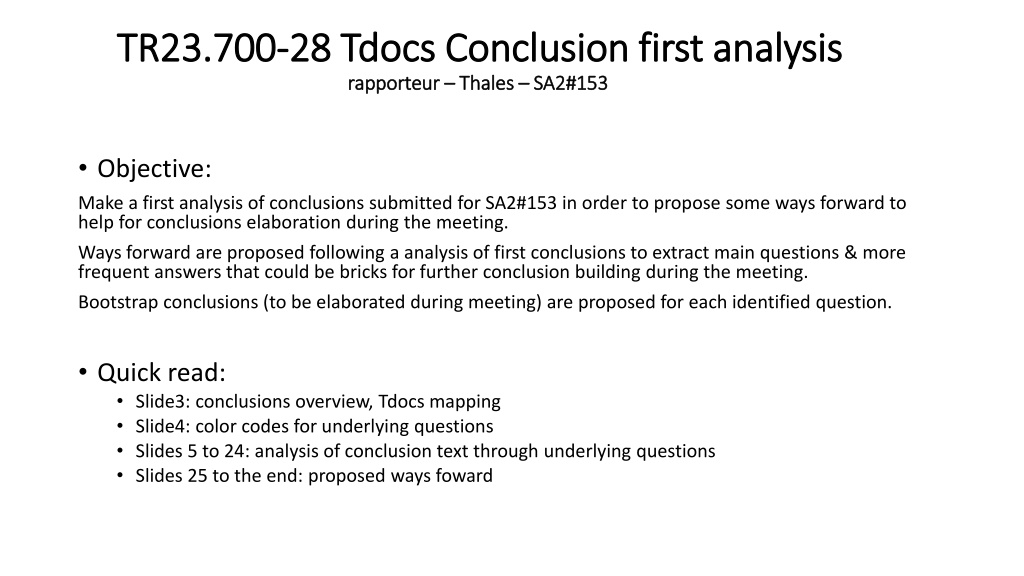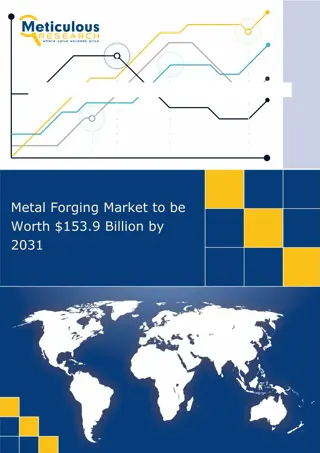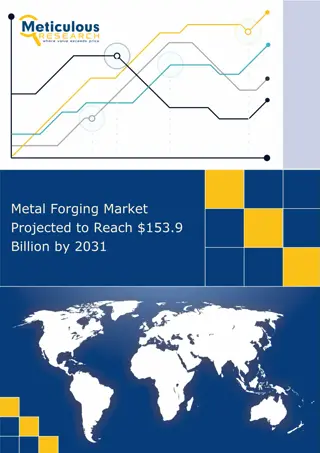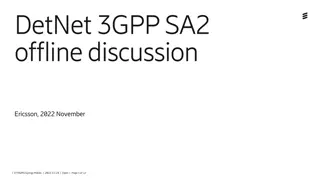First Analysis of Conclusions for SA2#153
Make a first analysis of conclusions submitted for SA2#153 to propose ways forward for elaboration during the meeting. Extract main questions & frequent answers to aid in conclusion building. Bootstrap conclusions are proposed for each identified question. Explore the overview of conclusions and Tdocs mapping, analyze conclusion texts, and suggest ways forward for further elaboration during the meeting.
Download Presentation

Please find below an Image/Link to download the presentation.
The content on the website is provided AS IS for your information and personal use only. It may not be sold, licensed, or shared on other websites without obtaining consent from the author.If you encounter any issues during the download, it is possible that the publisher has removed the file from their server.
You are allowed to download the files provided on this website for personal or commercial use, subject to the condition that they are used lawfully. All files are the property of their respective owners.
The content on the website is provided AS IS for your information and personal use only. It may not be sold, licensed, or shared on other websites without obtaining consent from the author.
E N D
Presentation Transcript
TR23.700 TR23.700- -28 28 Tdocs Tdocs Conclusion first Conclusion first analysis rapporteur rapporteur Thales Thales SA2#153 SA2#153 analysis Objective: Make a first analysis of conclusions submitted for SA2#153 in order to propose some ways forward to help for conclusions elaboration during the meeting. Ways forward are proposed following a analysis of first conclusions to extract main questions & more frequent answers that could be bricks for further conclusion building during the meeting. Bootstrap conclusions (to be elaborated during meeting) are proposed for each identified question. Quick read: Slide3: conclusions overview, Tdocs mapping Slide4: color codes for underlying questions Slides 5 to 24: analysis of conclusion text through underlying questions Slides 25 to the end: proposed ways foward
Recap of Key Issues and related requirements It has been agreed in evaluation part of TR that the Key Issues include the following requirements: KI#1: R1 "minimizing a period of no coverage" R2 "minimizing power consumption" R3 "UE determines that it has to remain with no service or it has to attempt to register on available different RAT's/ PLMNs to receive the normal service during discontinuous coverage in current NTN RAT" R4 "reduce the impact to target RAT or system due to large number of UEs triggering signalling load on the target RAT or system to receive normal service KI#2: R5 "UE does not attempt PLMN access when there is no network coverage" R6 "when there is network coverage the UE attempts PLMN access as needed e.g. to transfer signalling, transfer data or receive paging, etc."
Conclusions overview, Tdocs mapping 17 Tdocs are proposing conclusions, under different chapters proposals Type of Satellite Coverage Data and Transfer to Consumers S2-2208284 Mobility Management enhancement with discontinuous satellite coverage KI#1: R1 S2-2208511 S2-2208669 S2-220854 S2-2208379 (KI1 part) S2-2208849 S2-2208875 S2-2208931 R2 S2-2208784 Determination of Satellite Coverage Gaps S2-2208841 S2-2209184 part1 R3 S2-2208540 R4 S2-2208934 S2-2209184 part2 conclusion on satellite coverage information provision S2-2208877 S2-2209026 Power saving enhancement for UE in discontinuous coverage KI#2: R5 R6 S2-2208379 (KI2 part) S2-2208850 S2-2208932 No chapter indication S2-2208677 general mobility management and/or power saving
Conclusions analysis: underlying questions and associated color codes In the following slides, the conclusion texts of the 17 Tocs are analysed through several questions: - Which information AMF/MME has and how AMF/MME retrieves it (R1,R2,R5,R6) - What is the role of AMF/MME (R1,R2,R5,R6) - Which information UE has and how UE retrieves it (R1,R2,R5,R6) - What is the role of UE (R1,R2,R5,R6) - What is global system behaviour (R1,R2,R5,R6) - What is system behaviour for RAT/PLMN selection - What is system behaviour for signaling overload
Conclusions analysis general mobility management and/or power saving S2-2208284 The following are conclusions on mobility management and/or power saving: - exposure. The existing AF-provided values for Maximum Latency(s) and Maximum Response Time(s) can be provided to indicate suitable times for a UE using satellite access in discontinuous coverage. In addition, in-coverage and out-of-coverage times can be provided for a UE. The AMF/MME can use this information to determine suitable NAS timer and buffering time values. Satellite related coverage times can be provided by an AF to the MME/AMF via SCEF/NEF - deregistration timer values as already is defined for MME in Rel-17. In addition, the AMF may be pre-configured with suitable periodic registration timer value and
Conclusions analysis S2-2208511 The following are conclusions for mobility management and/or power saving: - The AMF/MME obtains satellite assistance information (e.g., ephemeris data) from OAM or a 3rd party server. The AMF/MME determines mobility management and power saving parameters based on the coverage information for the UE. If the AMF/MME detects that the UE in CM-CONNECTED is about to leave the current satellite coverage based on the coverage information, the AMF/MME may trigger N2/S1 release procedure to move UE into CM-IDLE state. AMF/MME configures mobility management and power saving parameters using UCU/GUTI reallocation procedures before the UE leaves the satellite coverage. Optionally, AMF can provide a backoff timer to prevent the UE from sending MO data/signalling while out of coverage. - - - -
Conclusions analysis S2-2208669 The following are conclusions on mobility management and/or power saving: - The AMF/MME obtains satellite related information (e.g. satellite ephemeris, satellite footprint) from OAM or a 3rd party server. - The AMF/MME obtains the coverage information for the UE, based on the UE location information, the satellite related information, and optionally UE mobility information from an AF/UE and/or NWDAF (only apply to 5GC). - For the case when UE mobility is known or predicable: - The UE initiates Mobility Registration Update procedure/TAU procedure using the existing mechanism defined in TS 23.502 [3] and TS 23.401 [5]. - The AMF/MME configures the UEs mobility management and power saving parameters, e.g. MRU/TAU timer, active time, eDRX, based on the coverage information, to make sure the UE in power saving mode out of network coverage, to avoid the network de-registering or detaching the UE, or attempting to page the UE during this time. The UE may use this information to help determine when it can access a network. - For the case when UE mobility is not known or predictable: - The UE notifies the AMF/MME when it is about to leave coverage. - The AMF/MME sets an implicit detach timer based on the coverage information to avoid de-registering or detaching the UE, or attempting to page the UE when it is in discontinuous coverage.
Conclusions analysis S2-2208784 It is concluded that preferable system assumptions (psa) and behaviour are the following: 1. (case1) If UE precise location and mobility is known or predicable by the NW, the NW determines the UE behaviour for power saving procedures (PSM, eDRX, MICO, HLCOM ) and plan the paging accordingly. AMF/MME needs to retrieve information of satellite coverage for the UE from dedicated processing in another node in CN and/or via SCEF/NEF. If possible, accurate coverage information is shared with UE. The necessary logic to determine if a (set of) position(s) or logical entity (Tracking Area) will (when and how) be included in satellite earth footprint for a given period is done: 1.1. (case1.1) In a CN Network Function in 5GC case and the information from Satellite Network Centre are conveyed via NEF. (case1.2) By external (to CN) Application Server, through SCEF interface, in EPC case. 1.2. 2. (case2) To cover the uses cases where the NW does not know UE precise location and mobility, it is necessary to have a backup mechanism where the UE determines its behaviour by itself, but with coverage information retrieves from the network with enhanced solution compared to R17. 3. The solutions for (a) must take precedence over the solutions for (b) if both co-exists.
Conclusions analysis R3: RAT/PLMN selection S2-2208841 The following aspects for RAT/PLMN selection are concluded as principles for the normative work. R17 specification for discontinuous coverage alone could not deal with all kinds of scenarios in 5G to fulfill the various service requirements. Sol#12 and #13 could help to enhance the service experience in some way. During satellite coverage gaps, the following conditions might be used to determine the deactivation of the Access Stratum function, the application of HLCOM function, and the access to other RAT/PLMN: - the service requirements (e.g. Service Continuity, latency of the user plane data transfer); - the network instruction; and - the UE inputs/preference.
Conclusions analysis S2-2209184 part1 On the aspect of alternative RAT/PLMN selection, the UDM configures in the UE the DisCoNoserviceapplicability parameter, based on the DisCoNoserviceapplicability parameter UE determines it shall remain in no service(and apply power saving mechanisms) or it can trigger registration on alternate RAT or PLMN to receive normal services. Following the procedure described in clause 4.15.6.2 of TS 23.502 [3], the AF can provision the DisCoNoserviceapplicability parameter into the UDM/UDR, what value UDM uses to configure in the UE is up to operator policy. The UDM configures DisCoNoserviceapplicability parameter in the UE per PLMN the exact details to achieve this is up to stage-3 groups. The UE after taking DisCoNoserviceapplicability flag into account can decide it if has to stay in current PLMN applying power saving mechanisms or select another PLMN/RAT by taking example information available to the UE as described in 6.13.1.
Conclusions analysis R4: Signalling overload S2-2208934 The following aspects are concluded for normative work: - MEO/LEO providing quasi-static fixed earth footprint with steerable beams is considered as the satellite type that needs the signalling overload control due to their insufficient randomization compared to MEO/LEO that provides earth moving coverage. - AMF determines the wait range based on network configuration and sends the wait range to the UE via Registration procedure or User Configuration Update procedure. Editor s Note: whether to use the same parameter in MINT or to define new parameter for satellite discontinuous coverage is FFS. Editor s Note: whether to define new mechanism to send the parameter to be compatible with 4G is FFS. - The UE will calculate the wait timer based on wait range o If the UE have to remain in no service, the UE will take the unavailable period (e.g. because of discontinuous coverage) into account to calculate the wait timer to reduce signalling overload and save energy. o If the UE can select available RAT/PLMN to continue the service, the UE will directly calculate the wait timer with received wait range with similar mechanism as defined in MINT to reduce signalling overload to the target system. - The UE will not initiate any NAS signalling to the target system when the wait timer is running. Editor s Note: more interim conclusions and/or whether specific solution is needed are FFS.
Conclusions analysis S2-2209184 part2 To solve overload impacts to target RAT/PLMN it is concluded to re-use the similar mechanisms available for MINT, i.e. UE derives the timers from the wait range configurations from network. The UE starts respective timers when entering discontinuous coverage and when coverage returns, at expiry of this timers UE attempts signalling on the network. The wait range configuration coding should take care that higher priority users are given better priority than normal UEs.
Conclusions analysis KI#1 Mobility Management enhancement with discontinuous satellite coverage S2-2208379 (KI1part) On Key Issue #1 it is concluded that: - The capability for the UE to be able to determine its NAS timer values based on its predicted unreachability periods needs to be specified. - The capability for the network to determine NAS timer values based on the UEs predicted unreachability period needs to be specified. - If the network determines the unreachability periods that affect the NAS timer values, the calculation of unreachability times based on orbit data is done outside the AMF in some other NF. Parameter provisioning framework can be re-used for the AF to provide the timer values to the AMF via the NEF.
Conclusions analysis S2-2208849 Following conclusions are proposed: - AMF/MME obtains satellite coverage information (e.g. satellite ephemeris) from AF (or a 3rd party server via NEF) or OAM. - UE obtains satellite ephemeris data relies on broadcast in a SIB as defined in TS 36.331. - AMF/MME determines the UEs mobility management based on the obtained UE information (e.g. location, mobility) and coverage information (e.g. ephemeris data) - Reuse the disaster roaming wait range configuration of the MINT work item to reduce the impact to target RAT/PLMN. Note: when there is no satellite coverage can be discussed during the normative phase. Whether the UE can be in CM-connected with RRC inactive and the AN release procedure is needed
Conclusions analysis S2-2208875 Based on the evaluation on candidate solutions, follow aspects can be concluded: - Combing UE capability, network capability and service requirement can be considered to determine UE whether to stay in power saving or access to alternative PLMN/RAT during no satellite coverage period. - Wait timer enabling randomizine UE access can be considered to alleviate signalling overload caused by massive access when coverage recovery or massive access to alternative PLMN/RAT when coverage is lost.
Conclusions analysis S2-2208931 The following aspects are concluded for normative work: - MEO/LEO satellite or satellite constellation that provides discontinuous coverage is considered as the satellite access in 5GS and EPS for the mobility management enhancement. - UE behaviour (e.g. AS deactivation) considering discontinuous coverage follows Rel.17 conclusion as defined in TS36.304 [17]. - AMF makes the paging enhancement decision by taking the satellite or satellite constellation discontinuous coverage information into account. o The paging enhancement means that the AMF will not initiate any paging request to the UEs that are in coverage gap based on the coverage map information. The AMF will initiate the paging when the coverage resumes based on buffered DL data or signalling or when the AMF receives UE requested TAU update (i.e. periodic registration update, mobility update in 5G). o The satellite coverage map information is provided directly to the AMF without AMF further calculation. o AMF will take the Tracking Area reported by RAN as the paging area. Editor s Note: the definition and format of the satellite coverage map information is FFS. Editor s Note: who will provide the coverage map information depends on the discussion. - AMF will notify the event of the UEs that are in coverage gap to AF/other NFs that have subscribed to UE mobility. Editor s Note: more interim conclusions and/or whether specific solution is needed are FFS.
Conclusions analysis KI#2 Power saving enhancement for UE in discontinuous coverage S2-2208379 (KI2 part) On Key Issue #2 it is concluded that: - The capability for the UE to initiate the NAS timer value negotiation using the UE calculated NAS timer values needs to be supported. - If the network (also) calculates the NAS timer values using its best understanding of the UE's location and trajectory as well as the satellite data, the AMF capability to negotiate the UE requested values needs to be supported. - If the UE's communication interval is known, then the negotiation of the NAS timer values should take it into account in addition to the unreachability periods to avoid forcing the UE to initiate signalling more often that its known application needs would require.
Conclusions analysis S2-2208850 Following conclusions are proposed: - AMF/MME determines the power saving parameters based on the obtained UE information (e.g. location, mobility) and coverage information (e.g. ephemeris data) for the UEs - AMF updates the power saving parameters to the UE during the UCU procedure - During the unavailability period, the AMF or MME maintains the UE context in CM-IDLE or ECM- IDLE. - FFS: Whether the UE can be in the in-active state can be discussion in the future.
Conclusions analysis S2-2208932 The following aspects are concluded for normative work: - MEO/LEO satellite or satellite constellation that provides discontinuous coverage is considered as the satellite access in 5GS and EPS for the power saving enhancement. - Power saving mode (PSM) parameters will be decided by AMF and include: o Periodic registration update timer o MICO mode with Active Time o MICO mode with Extended Connected time o eDRX - UE behaviour (e.g. request for eDRX, MICO mode with Active Time) considering discontinuous coverage follows Rel.17 conclusion. - AMF makes the decision of PSM parameters by taking the satellite or satellite constellation discontinuous coverage map information, UE mobility, UE trajectory and etc into account.
Conclusions analysis Type of Satellite Coverage Data and Transfer to Consumers S2-2208540 The following aspects are concluded for normative support. - Satellite coverage data is supported in the form of a coverage map for one or more fixed locations and times as described for Solution #15. - Satellite coverage data may be optionally supported for a known or predicted UE trajectory or mobility pattern as described for Solutions #17, #19 and #21. - Satellite coverage data may be transferred to a UE from an external server or an AF (internal or external to PLMN) as described for Solutions #15 and #22. - Whether UP or NAS via an AMF/MME (CP) will be used for the transfer is FFS and will depend on feedback from CT1. - If satellite coverage data is needed by an AMF, MME, the transfer may be supported by O&M.
Conclusions analysis Determination of Satellite Coverage Gaps S2-2208540 The following aspects are concluded for normative support. - Determination of satellite coverage gaps may be supported by UEs based on satellite coverage data received according to clause 8.x. For E-UTRAN UEs, the additional data defined in clause 8.x for determination of satellite coverage gaps will be supported together with what is already defined in Rel.17 TS 36.331 [16]. Whether NG-RAN will support ephemeris data and coverage parameters to the UE in RRC for NR will be decided by RAN WGs. - UEs will indicate an impending satellite coverage gap, when known, to an AMF or MME as described for Solution #6 and Solution #16 and will notify the AMF or MME when the satellite coverage gap has ended as described for Solution #16. - An MME, AMF may verify an impending satellite coverage gap provided by a UE using satellite coverage data (e.g. provided by O&M) as defined in clause 8.x. - An AMF or MME uses an indication of an impending satellite coverage gap provided by a UE or determined by the AMF or MME to avoid paging the UE during the coverage gap and initiate procedures to buffer DL data. - An MME or AMF may adjust power saving parameters for a UE (for eDRX, MICO or PSM) to reduce UE power consumption during a satellite coverage gap as described for Solution #1, Solution #2, Solution #5.
Conclusions analysis conclusion on satellite coverage information provision S2-2208877 Based on the evaluation on candidate solutions, follow aspects can be concluded: - The UE determines its in or out of satellite coverage in the current position based on the RAN broadcast satellite information. - The AMF/MME obtains satellite information (e.g. ephemeris data, satellite footprint) from external server or AF in order to perform mobility management or power saving. - The AMF/MME determines the satellite coverage information for a UE based on satellite information, UE given location information or mobility patterns. - The AMF/MME provides the satellite coverage information to the UE if necessary.
Conclusions analysis S2-2209026 The following aspects are concluded as principles for the normative work: - Coverage information shall be provisioned to both UE and AMF/MME; - Coverage information shall include timing information when UE moves out/in of NTN coverage. The coding or the detail of the values will be determined in CT WGs; - AMF/MME shall not generate coverage information by itself to be used for setting up the power saving parameters or handling mobility management of NTN UE. Instead AMF/MME shall request those information to other NF such as NWDAF; and - The NF that generates coverage information shall be located inside 3GPP domain.
Conclusions analysis No chapter indication S2-2208677 The following aspects are concluded as principles for the normative work: The UDM in HPLMN configures a DisCoNoserviceapplicability parameter in per PLMN basis to the UE using UE Parameters Update via UDM Control Plane Procedure as described in clause 4.20 of TS 23.502 [3]. Based on DisCoNoserviceapplicability parameter of the serving PLMN, the UE using Satellite RAT determines whether to negotiate power saving mechanisms before entering no service discontinues NTN coverage and whether to remain in no service in current PLMN after entering no service discontinues NTN coverage. The Steering of Roaming information is enhanced to configure a roaming UE with the list of preferred PLMN/access technology combinations, and the DisCoNoserviceapplicability parameter is in per PLMN/Satellite RAT basis. Editor s Note: It is FFS whether any RAN impact is needed for 5GC to support data rate exposure to the AF.
Proposed ways forward (1) R4: Signalling overload Conclusions proposed in S2-2208934 and S2-2209184 (second part) are based on the same principle: UE derives the timers from the wait range configurations from network. This principle is also mentioned in S2-2208849 and S2-2208875 Proposed way forward to elaborate final conclusion to R4 is to merge S2-2208934 and S2-2209184 (second part) into S2-2208934, which proposed more context, and continue the discussion in S2-2208934 R3: RAT/PLMN selection Conclusions proposed in S2-2208841, S2-2208184, S2-2208875, S2-2208677 are dealing with the requirement. Concrete principle that UDM in HPLMN configures a DisCoNoserviceapplicability parameter in per PLMN basis to the UE is present in S2-2208184 and S2-2208677, where two other contributions remains more generic Proposed way forward is to merge S2-2208841, S2-2208184, S2-2208875, S2-2208677 into S2-2208184 and continue the discussion in S2-2208184
Proposed ways forward (2) R1, R2, R5, R6 No quick win as per R3 and R4 because several different options are proposed for the 5 basic underlying questions: - Which information AMF/MME has and how AMF/MME retrieves it? - - - What is the role of AMF/MME? Which information UE has and how UE retrieves it ? What is the role of UE ? - What is global system behaviour ? First need is to analyse responses panel to each of these question, to see if converging solution is possible or if decision shall be taken
Proposed ways forward (3) R1, R2, R5, R6 - Which information AMF/MME has and how AMF/MME retrieves it? (I) Related statements in conclusions: S2-2208284: Satellite related coverage times can be provided by an AF to the MME/AMF via SCEF/NEF exposure. The existing AF-provided values for Maximum Latency(s) and Maximum Response Time(s) can be provided to indicate suitable times for a UE using satellite access in discontinuous coverage S2-2208511: The AMF/MME obtains satellite assistance information (e.g., ephemeris data) from OAM or a 3rd party server. S2-2208669: The AMF/MME obtains satellite related information (e.g. satellite ephemeris, satellite footprint) from OAM or a 3rd party server. The AMF/MME obtains the coverage information for the UE, based on the UE location information, the satellite related information, and optionally UE mobility information from an AF/UE and/or NWDAF (only apply to 5GC). S2-2208784: AMF/MME needs to retrieve information of satellite coverage for the UE from dedicated processing in another node in CN and/or via SCEF/NEF. The necessary logic to determine if a (set of) position(s) or logical entity (Tracking Area) will (when and how) be included in satellite earth footprint for a given period is done: In a CN Network Function in 5GC case and the information from Satellite Network centre are conveyed via NEF. By external (to CN) Application Server, through SCEF interface, in EPC case. S2-2208379: If the network determines the unreachability periods that affect the NAS timer values, the calculation of unreachability times based on orbit data is done outside the AMF in some other NF. Parameter provisioning framework can be re-used for the AF to provide the timer values to the AMF via the NEF S2-2208849: AMF/MME obtains satellite coverage information (e.g. satellite ephemeris) from AF (or a 3rd party server via NEF) or OAM. S2-2208931: The satellite coverage map information is provided directly to the AMF without AMF further calculation. AMF will take the Tracking Area reported by RAN as the paging area. S2-2208850: based on the obtained UE information (e.g. location, mobility) and coverage information (e.g. ephemeris data) for the Ues S2-2208540: If satellite coverage data is needed by an AMF, MME, the transfer may be supported by O&M S2-2208877: The AMF/MME obtains satellite information (e.g. ephemeris data, satellite footprint) from external server or AF in order to perform mobility management or power saving. S2-2209026: AMF/MME shall not generate coverage information by itself to be used for setting up the power saving parameters or handling mobility management of NTN UE. Instead AMF/MME shall request those information to other NF such as NWDAF; and the NF that generates coverage information shall be located inside 3GPP domain
Proposed ways forward (4) R1, R2, R5, R6 - Which information AMF/MME has and how AMF/MME retrieves it? (II) Proposed way forward: Consider for further elaboration during meeting to start with following bootstrap: - AMF/MME shall not generate coverage information by itself to be used for setting up the power saving parameters or handling mobility management of NTN UE AMF/MME obtains satellite coverage information (e.g. satellite ephemeris, satellite footprint) from other NF such as NWDAF or new NF or AF (or a 3rd party server via NEF) or OAM Editor s Note: who will provide the coverage map information depends on the discussion. - -
Proposed ways forward (5) - R1, R2, R5, R6 - What is the role of AMF/MME? (I) Related statements in conclusions: S2-2208284: The AMF/MME can use this information to determine suitable NAS timer and buffering time values. In addition, the AMF may be pre-configured with suitable periodic registration timer value and deregistration timer values as already is defined for MME in Rel-17. The AMF/MME determines mobility management and power saving parameters based on the coverage information for the UE. If the AMF/MME detects that the UE in CM-CONNECTED is about to leave the current satellite coverage based on the coverage information, the AMF/MME may trigger N2/S1 release procedure to move UE into CM-IDLE state. AMF/MME configures mobility management and power saving parameters using UCU/GUTI reallocation procedures before the UE leaves the satellite coverage. Optionally, AMF can provide a backoff timer to prevent the UE from sending MO data/signallingwhile out of coverage. The AMF/MME configures the UEs mobility management and power saving parameters, e.g. MRU/TAU timer, active time, eDRX, based on the coverage information, to make sure the UE in power saving mode out of network coverage, to avoid the network de-registering or detaching the UE, or attempting to page the UE during this time. The UE may use this information to help determine when it can access a network. The AMF/MME sets an implicit detach timer based on the coverage information to avoid de-registering or detaching the UE, or attempting to page the UE when it is in discontinuous coverage. the NW determines the UE behaviour for power saving procedures (PSM, eDRX, MICO, HLCOM ) and plan the paging accordingly. The capability for the network to determine NAS timer values based on the UEs predicted unreachability period needs to be specified. AMF/MME determines the UEs mobility management based on the obtained UE information (e.g. location, mobility) and coverage information (e.g. ephemeris data) AMF makes the paging enhancement decision by taking the satellite or satellite constellation discontinuous coverage information into account. The paging enhancement means that the AMF will not initiate any paging request to the UEs that are in coverage gap based on the coverage map information. The AMF will initiate the paging when the coverage resumes based on buffered DL data or signalling or when the AMF receives UE requested TAU update (i.e. periodic registration update, mobility update in 5G). AMF will notify the event of the UEs that are in coverage gap to AF/other NFs that have subscribed to UE mobility. If the network (also) calculates the NAS timer values using its best understanding of the UE's location and trajectory as well as the satellite data, the AMF capability to negotiate the UE requested values needs to be supported. If the UE's communication interval is known, then the negotiation of the NAS timer values should take it into account in addition to the unreachability periods to avoid forcing the UE to initiate signalling more often that its known application needs would require. AMF/MME determines the power saving parameters. AMF updates the power saving parameters to the UE during the UCU procedure - During the unavailability period, the AMF or MME maintains the UE context in CM-IDLE or ECM-IDLE Power saving mode (PSM) parameters will be decided by AMF and include: Periodic registration update timer, MICO mode with Active Time, MICO mode with Extended Connected time,eDRX. AMF makes the decision of PSM parameters by taking the satellite or satellite constellation discontinuous coverage map information, UE mobility, UE trajectory and etc into account. An MME, AMF may verify an impending satellite coverage gap provided by a UE using satellite coverage data (e.g. provided by O&M) as defined in clause 8.x. An AMF or MME uses an indication of an impending satellite coverage gap provided by a UE or determined by the AMF or MME to avoid paging the UE during the coverage gap and initiate procedures to buffer DL data. An MME or AMF may adjust power saving parameters for a UE (for eDRX, MICO or PSM) to reduce UE power consumption during a satellite coverage gap as described for Solution #1, Solution #2, Solution #5. S2-2208511: - - S2-2208669: S2-2208784: S2-2208379: S2-2208849: S2-2208931: S2-2208379: S2-2208850: S2-2208932: S2-2208540: S2-2208877: The AMF/MME determines the satellite coverage information for a UE based on satellite information, UE given location information or mobility patterns. The AMF/MME provides the satellite coverage information to the UE if necessary.
Proposed ways forward (6) - R1, R2, R5, R6 - What is the role of AMF/MME? (II) Proposed way forward: Consider for further elaboration during meeting to start with following bootstrap: The AMF/MME configures the UEs mobility management and power saving parameters, e.g. MRU/TAU timer, active time, eDRX, based on the coverage information, to make sure the UE in power saving mode out of network coverage, to avoid the network de-registering or detaching the UE, or attempting to page the UE during this time. The UE may use this information to help determine when it can access a network. The AMF/MME sets an implicit detach timer based on the coverage information to avoid de-registering or detaching the UE, or attempting to page the UE when it is in discontinuous coverage.
Proposed ways forward (7) - Which information UE has and how UE retrieves it Related statements in conclusions: S2-2208284: In addition, in-coverage and out-of-coverage times can be provided for a UE S2-2208784: If possible, accurate coverage information is shared with UE. coverage information retrieves from the network with enhanced solution compared to R17. S2-2208849: UE obtains satellite ephemeris data relies on broadcast in a SIB as defined in TS 36.331. S2-2208540: Satellite coverage data may be transferred to a UE from an external server or an AF (internal or external to PLMN) as described for Solutions #15 and #22. Whether UP or NAS via an AMF/MME (CP) will be used for the transfer is FFS and will depend on feedback from CT1. S2-2208877: The UE determines its in or out of satellite coverage in the current position based on the RAN broadcast satellite information. Proposed way forward: Consider for further elaboration during meeting to start with following bootstrap: If possible, accurate coverage information is shared with UE. coverage information retrieves from the network with enhanced solution compared to R17. Satellite coverage data may be transferred to a UE from an external server or an AF (internal or external to PLMN) Editor s Note: LS need to have feedback from CT1 on whether UP or NAS via an AMF/MME (CP) will be used for the transfer depends on the discussion.
Proposed ways forward (8) - What is the role of the UE? (I) Related statements in conclusions: S2-2208669: The UE initiates Mobility Registration Update procedure/TAU procedure using the existing mechanism defined in TS 23.502 [3] and TS 23.401 [5]. S2-2208784: UE determines its behaviour by itself S2-2208379: The capability for the UE to be able to determine its NAS timer values based on its predicted unreachability periods needs to be specified. The capability for the UE to initiate the NAS timer value negotiation using the UE calculated NAS timer values needs to be supported. S2-2208931: UE behaviour (e.g. AS deactivation) considering discontinuous coverage follows Rel.17 conclusion as defined in TS36.304 [17]. S2-2208932: UE behaviour (e.g. request for eDRX, MICO mode with Active Time) considering discontinuous coverage follows Rel.17 conclusion. S2-2208540: Determination of satellite coverage gaps may be supported by UEs based on satellite coverage data received according to clause 8.x. For E-UTRAN UEs, the additional data defined in clause 8.x for determination of satellite coverage gaps will be supported together with what is already defined in Rel.17 TS 36.331 [16]. UEs will indicate an impending satellite coverage gap, when known, to an AMF or MME as described for Solution #6 and Solution #16 and will notify the AMF or MME when the satellite coverage gap has ended as described for Solution #16.
Proposed ways forward (9) - What is the role of the UE?(II) Proposed way forward Consider for further elaboration during meeting to start with following bootstrap: -The capability for the UE to be able to determine its NAS timer values based on its predicted unreachability periods needs to be specified. -The capability for the UE to initiate the NAS timer value negotiation using the UE calculated NAS timer values needs to be supported. -Determination of satellite coverage gaps may be supported by UEs based on satellite coverage data received In this case, UEs will indicate an impending satellite coverage gap, when known, to an AMF or MME as described by unreachability period and will notify the AMF or MME when the satellite coverage gap has ended as described accordingly.
Proposed ways forward (10) - Global system behaviour (I) Related statements in conclusions: S2-2208669: For the case when UE mobility is known or predicable, , For the case when UE mobility is not known or predictable: S2-2208784: If UE precise location and mobility is known or predicable by the NW, , the NW does not know UE precise location and mobility, , The solutions for (a) must take precedence over the solutions for (b) if both co-exists. S2-2208931: MEO/LEO satellite or satellite constellation that provides discontinuous coverage is considered as the satellite access in 5GS and EPS for the mobility management enhancement. S2-2208932: MEO/LEO satellite or satellite constellation that provides discontinuous coverage is considered as the satellite access in 5GS and EPS for the power saving enhancement S2-2208540: Satellite coverage data is supported in the form of a coverage map for one or more fixed locations and times as described for Solution #15.Satellite coverage data may be optionally supported for a known or predicted UE trajectory or mobility pattern as described for Solutions #17, #19 and #21. Whether NG-RAN will support ephemeris data and coverage parameters to the UE in RRC for NR will be decided by RAN WGs S2-2208540: Coverage information shall be provisioned to both UE and AMF/MME; Coverage information shall include timing information when UE moves out/in of NTN coverage. The coding or the detail of the values will be determined in CT WGs;
Proposed ways forward (11) - Global system behaviour (II) Proposed way forward Consider for further elaboration during meeting to start with following bootstrap: - MEO/LEO satellite or satellite constellation that provides discontinuous coverage is considered as the satellite access in 5GS and EPS for the power saving enhancement - Coverage information shall be provisioned to both UE and AMF/MME - Coverage information shall include timing information when UE moves out/in of NTN coverage - Editor s Note: 2 different valuable approaches coexists in conclusions. In the first one, Network centric, the AMF/MME determines the PSM parameters taking into account satellite assistance data, in the second one, UE centric, the UE elaborates knowledge of coverage gaps and informs Network about its unavailability. Both makes sense but it has to be clearly determined the applicability domain (uses cases) for each and the priority rules between both. Conclusions here will depend on the discussion during the meeting.
























